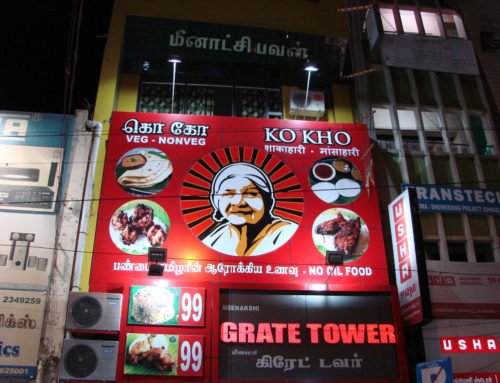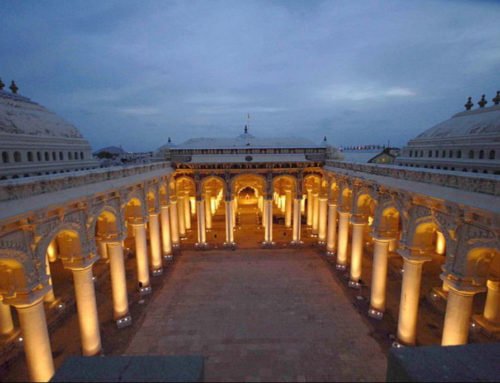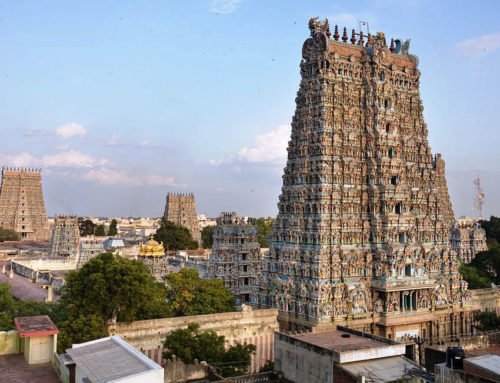Overview
- Features: Temple complex showcasing 12 gopuras (gateway towers) embellished with colourful stucco figures
- Opening Times: 4:00 am to 12:30 pm & 4:00 pm to 9:30 pm, daily
- Best Time to Visit: Late October to early March
- Duration: 1 to 2 hours
- Travelled By: Foot
- Cost: Temple Art Museum – Indian/foreigner Rs 5/50, camera Rs 50
- Address: Madurai, Tamil Nadu, India
- Type: Temple
Author Reviews[display_rating_item_results rating_form_id=”2″ rating_entry_ids=”1″ show_category_filter=”false” show_options=”true” result_type=”star_rating” preserve_max_rating=”true” show_title=”false” show_count=”false” ]
Total Rating: [display_rating_result rating_form_id=”2″ show_count=”false” show_rich_snippets=true] [accordions load=”1″] [accordion title=”User Reviews” last] [display_rating_item_results rating_form_id=”5″ show_options=”true” result_type=”star_rating” preserve_max_rating=”true” show_title=”false” show_count=”true” show_rich_snippets=true] [/accordion] [accordion title=”Add Review”][display_rating_form show_email_input=”true” show_comment_textarea=”true” show_name_input=”true” rating_form_id=”5″] [/accordion] [/accordions]
Summary
The Sri Meenakshi Temple in Madurai is the best temple in South India and, as a result, makes it on to everyone’s list of places to visit in South India. Read this post for interesting facts about Meenakshi Temple Madurai as well as all the important information you will need to plan your visit to this spectacular attraction.
Interesting Facts About Meenakshi Temple Madurai
The Sri Meenakshi Temple in Madurai is the best temple in South India and, as a result, makes it on to everyone’s list of places to visit in South India. Read this post for interesting facts about Meenakshi Temple Madurai as well as all the important information you will need to plan your visit to this spectacular attraction.
Interesting Facts about Sri Meenakshi Temple Madurai
- The Sri Meenakshi Temple is considered to be the height of South Indian Vijayanagar temple architecture
- In fact, the temple is as vital to the aesthetic heritage of South India as the Taj Mahal is to North India
- Meenakshi Temple was on the list of top 30 nominees for the “New Seven Wonders of the World”
- The temple forms the heart and lifeline of the 2,500 year old city of Madurai
- The Meenakshi Temple has been mentioned since antiquity in Tamil literature
- Sri Meenakshi Temple is the abode of the triple-breasted, fish-eyed goddess Meenakshi Amman
- ‘Fish-eyed’ is an adjective for perfect eyes in classical Tamil poetry
- The temple attracts 15,000 visitors a day, around 25,000 on Fridays, and receives an annual revenue of Rs sixty million (~US$1 million)
- There are an estimated 33,000 sculptures in the temple
- The annual 10-day Meenakshi Tirukalyanam festival is celebrated during April and May and attracts 1 million visitors
[singlepic id=5590 w=720 h=560 float=center]
FAQs about Meenakshi Temple
Below are the answers to some frequently asked questions about Meenakshi Temple.
Who Built Meenakshi Temple?
The Meenakshi Temple was designed in 1560 by Vishwanatha Nayak and built during the reign of Tirumalai Nayak, but its history goes back 2000 years to the time when Madurai was a Pandyan capital (7th-10th centuries).
Where is Meenakshi Temple Located?
The Meenakshi Temple is located in the heart of the city of Madurai in Tamil Nadu, South India.
Distance from Madurai Railway Station to Meenakshi Temple
The Meenakshi Temple is situated very close to the Madurai Junction railway station and can easily be walked to. In terms of distance, the temple is 1.7 km east of the Madurai railway station.
Meenakshi Temple Timings
The Meenakshi Temple is open daily from 4:00 am to 12:30 pm & 4:00 pm to 9:30 pm.
Madurai Meenakshi Temple Pooja Timings
The temple is a hive of activity, with a colourful temple elephant, flower sellers and musical performances. There is an evening ceremony when an image of Sundareswarar is carried in procession, to a heady accompaniment of whirling pipe and drum music and clouds of incense, from the shrine near the east gopuram to Meenakshi, to ‘sleep’ by her side; he is returned first thing the next morning. The procession around the temple is occasionally led by the elephant and a cow. During the day the elephant is on continual duty, ‘blessing’ visitors with its trunk and then collecting a small offering.
Tips for Visiting the Meenakshi Temple
Much of the temple is off-limits to non-Hindus, but lay people can enter at the eastern gopuram. Allow plenty of time to see this temple and be warned: dress codes have been tightened, and no legs should be exposed for either gender, or shoulders (for women). If you’re deemed to be immodestly dressed an enterprising young man from the shop across the road will sell you a dhoti.
You are restricted from carrying cameras, mobile phones, bottles, food and many other items, so it is advisable to leave your bags and other carry-on items in your hotel room before visiting the temple.
Early mornings or late evenings are the best times to avoid crowds, and there’s often classical dance somewhere in the complex on the weekends. ‘Temple guides’ charge negotiable fees, rarely below Rs 200, so prepare to negotiate and be aware that they are often fronts for emporiums and tailor shops.
Madurai Meenakshi Temple Map
[singlepic id=5404 w=720 h=560 float=center]
Meenakshi Temple History
The Meenakshi Temple is dedicated to the triple-breasted, fish-eyed goddess Meenakshi Amman.
According to legend, the beautiful Meenakshi was born with three breasts and this prophecy: her superfluous breast would melt away when she met her husband. The event came to pass when she met Shiva and took her place as his consort.
Meenakshi Amman Temple Architecture
[singlepic id=5595 w=720 h=560 float=center]
The temple complex is divided into a number of concentric quadrangular enclosures contained by high masonry walls. It is one of the few temples in Tamil Nadu to have four entrances facing four directions. At the core of the temple complex are the two sanctums for Meenakshi and Sundareswarar, surrounded by a number of smaller shrines and grand pillared halls. Meenakshi (the “Fish-eyed Goddess”) has a temple to the south, and Shiva, known here as Sundareswarar (the “Handsome God”), a temple to the west. Since she is the presiding deity the daily ceremonies are first performed in her shrine and, unlike the practice at other temples, Sundareswarar plays a secondary role.
[singlepic id=5594 w=720 h=560 float=center]
It’s not so much a temple as a 6-hectare complex enclosed by 12 gopurams (gateway towers), all of which are carved with a staggering array of gods, goddesses, demons and heroes. The oldest gopuram is the eastern one, built by Maravarman Sundara Pandyan during 1216-1238; the highest is the southern tower which towers 52m over Madurai. Their soaring multi-storeyed towers rise from solid granite bases, and are covered with colourful stucco figures of gods, goddesses, mythical animals and monsters which are renewed and painted every 12 years – the most recent touch-up having been completed in February 2009. There are about 4000 granite sculptures on the lower levels. In addition to the Golden Lotus tank and various pillared halls there are five vimanas over the sanctuaries. There are two golden sculptured vimanas, the shrines over the garbhagrihas (sanctums) of the main deities.
Detailed Information about Meenakshi Temple
The main entrance to the Meenakshi Temple is through a small door of the Ashta Sakthi Mandapa (“Hall of the Eight Goddesses”) which projects from the wall, south of the eastern gopuram. This mandapa has sculpted pillars representing the eight forms of the Goddess Shakti. Next to this hall is the Meenakshi Nayaka Mandapa, a spacious columned hall used for shops and stores. This hall has a votive lamp-holder with 1,008 lamps, which are lit on festive occasions and present a spectacular sight.
[singlepic id=5593 w=720 h=560 float=center]
The adjacent seven-storeyed Chitra Gopura, is the tallest tower in the complex. Next to it is the Potramarai Kulam, or the sacred Tank of the “Golden Lotus”, with a lamp in the centre, surrounded by pillared cloisters and steps down to the waters. It is surrounded by pillared corridors that once bore paintings from the Vijayanagar period.
[singlepic id=5602 w=720 h=560 float=center]
Only a fraction of 17th and 18th century paintings of Nayak period survives and one such portion is found in the small portico on the western side of the tank. It depicts the marriage of Sundareswarar and Meenkashi attended by Vijayaranga Chokkanatha and Rani Mangammal. The painting is executed on a vivid red background, with delicate black linework and large areas of white, green and ochre. The celestial couple is seated inside an architectural frame with a flowering tree in the background.
The Sangam legend speaks of the test that ancient manuscripts had to undergo: they were thrown into the sacred tank, and only if they floated were they considered worthy of further study. The north gallery has murals relating 64 miracles said to have been performed by Shiva, and the southern gallery has marble inscriptions of the 1330 couplets of the Tamil Book of Ethics.
[singlepic id=5598 w=720 h=560 float=center]
To the west of the tank is the Oonjal Mandapa, the pavilion leading to the Meenakshi Shrine. This shrine is one of the two main shrines comprising two concentric corridors and many halls and galleries. Here the pillars are carved in the form of the mythical beast yali which recurs in temples throughout the region. Golden images of Meenakshi and Sundareswarar are brought to the oonjal or swing each Friday evening where they are worshipped.
Two cages with squawking parrots, Meenakshi’s green bird that brings luck, hang from the ceiling of the neighbouring Kilikootu Mandapam (“Bird Cage Corridor”), which is flanked by finely carved columns. The space was once used to keep green parrots that were trained to utter the name of Meenakshi. The Meenakshi shrine with the principal image of the goddess, stands in its own enclosure with smaller shrines around it.
[singlepic id=5592 w=720 h=560 float=center]
Here lies the bed to which Meenakshi’s “husband”, in the form of Sundareswarar’s image, is brought every night from his own shrine, the Sundareswarar Shrine, which stands to the north of the tank and is guarded by two tall dwarapalas. The god resides in this, the second main shrine, amid columns that bear the fish motifs emblematic of his wife.
In the northeast corner, the superb sculptures of the divine marriage of Meenakshi and Sundareswarar being blessed by Vishnu and Brahma, and Shiva in his 24 forms are depicted on ornately carved pillars in the 19th-century “Flagpole Hall” or Kambathadi Mandapa, around a golden flagstaff with 32 sections symbolizing the human backbone, and a pavilion with a seated Nandi (sacred bull). Sculptures of Shiva and Kali trying to out-dance one another are pelted with balls of ghee by devotees.
[singlepic id=1369 w=720 h=560 float=center]
The central shrine of Meenakshi and her consort Sundareswarar are surrounded by three enclosures and each of these are protected by four minor towers at the four points of the compass, the outer tower growing larger and reaching higher to the corresponding inner one. The Meenakshi shrine has the emerald-hued black stone image of Meenakshi. The Sundareswarar shrine lies at the centre of the complex, suggesting that the ritual dominance of the goddess developed later.
Both the Meenakshi and Sundareswarar shrines have gold plated Vimanam (tower over sanctum). The golden top can be seen from a great distance in the west through the apertures of the two successive towers. The area covered by the shrine of Sundareswarar is exactly one fourth of the area of the temple and that of Meenakshi is one fourth that of Sundareswarar.
Thousand Pillar Hall of Meenakshi Temple
[singlepic id=5596 w=720 h=560 float=center]
The mid-16th century Thousand Pillar Hall is in the northeast corner of the complex and has two rows of pillars carved with images of yali (mythological beast with body of lion and head of an elephant), commonly used as the symbol of Nayak power. The 985 exquisitely carved columns include a lady playing the vina, a dancing Ganesh, and a gypsy leading a monkey. The hall was built in 1569 byAriyanatha Mudaliar, prime minister and general of Viswanatha Nayak, the first Nayaka of Madurai (1559–1600), and blends engineering skill and artistic vision.
At the entrance of the hall is the statue of Ariyanatha Mudaliar seated on a horse-back, flanking one side of the entrance to the temple. The statue is periodically garlanded by worshippers. Each pillar in the hall is a carved monument of the Dravidian sculpture. The more prominent among the carved figures are those of Rati (wife of Kama), Karthikeya,Ganesha, Shiva as a wandering mendicant and endless number of yalis (mythical figures of lions).
[singlepic id=5601 w=720 h=560 float=center]
The Temple Art Museum here exhibits temple art and architecture, fine brass and stone images, friezes and photos (the labelling could be improved) of the 1200 years old history of the temple are displayed. Just inside the museum to the right is a cluster of five musical pillars carved out of a single stone. Each pillar produces a different note which vibrates when tapped. Nayaka musicians could play these as an instrument.
The Kalyana Mandapa, to the south of the pillared hall, is where the marriage of Shiva and Parvati is celebrated every year during the Chitirai Festival in mid-April.
The Nandi pavilion is to the east and is often packed with market stalls peddling flowers, trinkets and coconuts. The 100-m (328-ft) long Pudu Mandapa (New Mandapa), across the road from the East Tower, is lined with yet more beautiful sculptures of yalis, Nayaka rulers and elephants. Built by Tirumalai Nayaka in 1635, it now houses a market selling saris, jewellery and spices. Beyond this lies the base of the unfinished Raya Gopuram which was planned to be the tallest in the country.
Northeast of the Meenakshi Temple, off N Avani Moola Street, is the flower market, a profusion of colour and activity which is best seen between 5:00 and 7:30 in the morning. It is a two-storey hall with piles of jasmine of all colours, lotuses, and huge jumbles of floral prettiness amid a sea of decomposing mulch of flowers trampled underfoot.
Festivals celebrated at Meenakshi Temple
[singlepic id=5588 w=720 h=560 float=center]
The most important festival associated with the temple is Meenakshi Thirukalyanam Chitirai festival (the divine marriage of Meenakshi) that is celebrated in April every year. The wedding of the divine couple is regarded as a classic instance of South Indian female-dominated marriage, an arrangement referred as “Madurai marriage”. The male dominated marriage is called “Chidambaram marriage”, referring to Shiva’s uncontested dominance, ritual and mythic, at the famous Shiva temple of Chidhambaram. The marriage brings together rural and urban people, deities and mortals, Saivas (those who worship Shiva) and Vaishnavas (those who worship Vishnu) in order to celebrate Meenakshi as the royal monarch. During the one month period, there are a number of events including the “Ther Thiruvizhah” (chariot festival) and “Theppa Thiruvizhah” (float festival).
Major Hindu festivals like Navrathri and Shivrathri are also celebrated in the temple.
Like most Shakti temples in Tamil Nadu, the Fridays during the Tamil months of Aadi (July–August) and Thai (January – February) are celebrated in the temple by thousands of devotees.
“Avani Moola Utsavam” is a 10-day festival mainly devoted to Sundareswarar. It describes his various Thiruvilayadal, Shiva’s sacred games.
Tell us what you think. What attracts you to Meenakshi Temple in Madurai? If you’ve been to the temple before, please share any ideas or tips to help make a visit here more memorable.
We love to hear from you so please leave your comments below.





